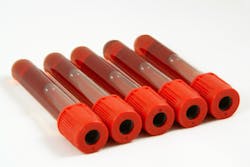Standing at the patient’s bedside in the emergency room, I watch as the phlebotomist adjusts the patient’s arm to collect blood samples. The phlebotomist ties the tourniquet around the patient’s arm and searches the antecubital area for a good vein. She does not feel or see one, so she unties the tourniquet and moves to the patient’s hand. After palpating the patient’s hand for several minutes, the phlebotomist cleans the area with alcohol, then performs venipuncture into a small vein. In an attempt to get blood flow, the phlebotomist adjusts the needle; however, after several minutes of no blood return, she removes the needle. The phlebotomist then asks me to pass her a small container from her tray. I pass the tube only to witness the unthinkable: using the micro-tube, she scoops up blood drops on top of the patient’s hand …
Clinical laboratorians depend on phlebotomists to collect quality samples. Phlebotomists are the laboratorians’ pre-analytical coordinators. We are the vanguard of our medical laboratories. Daily, laboratorians report lifesaving or life-altering results. Primary healthcare providers depend on us; they relay clinical lab information to their patients, usually without a second thought as to its accuracy.
When a sample reaches the lab, laboratorians are not going to question whether it is capillary blood in the capillary container—they trust that it is. Having said that, it is possible that after viewing the results, a testing tech may question them. Case in point: I have spoken with colleagues who said that when they questioned a low 2mg/dl Ca level, the phlebotomist admitted having pulled blood that had been from an EDTA tube and put it in a serum separator tube, which does not contain any additive.
It is important for phlebotomists to remember that there are checks and balances when it comes to clinical laboratory testing. Having attended and graduated from an accredited phlebotomy program, and having passed the National Certification Exam, my best advice, based on my years of working as a phlebotomist while attending medical technology school, is to implement a required annual written competency assessment with merit-based reward. Rewards can be as simple as adding half a day to an employee’s paid time-off. The competency assessment should consist of case studies to help the phlebotomist think through the scenario. Not only will this improve the quality of blood samples, but it contributes to saving healthcare operational costs in the end. Preanalytical errors damage an institution’s reputation, diminish confidence in healthcare services, and contribute to a significant increase in the total operating costs, both for hospital and laboratory.1
A phlebotomist must demonstrate proper blood collecting skills at all times. One reason why is that you never know who might be accompanying the patient during the blood draw: it might be someone who will know if you are doing it wrong!
You may think I’m being facetious, but I am not. In fact, I was part of such a situation—not as a phlebotomist, but as a “civilian.” I accompanied a friend to an ER visit and was with her during the blood draw. Here’s what happened:
As the phlebotomist entered the room, I moved to the opposite side of the bed to give her space. Upon entering, the phlebotomist simply announced, “I’m here to draw blood.” She didn’t introduce herself or state which department she was from—which is included in basic phlebotomy training. The phlebotomist then placed the collection tray at the end of the bed on the food stand.
Next, the phlebotomist identified the patient using the two-step identification method, asking the patient to state her name and checking her hospital identification bracelet. The phlebotomist took out all the blood-collecting tools: tourniquet, alcohol pad, butterfly needle set, gauze, and band-aid, as well as, a red and purple top tube. The phlebotomist then tied the tourniquet around the patient’s left arm and searched the antecubital area for a good vein. She did not feel or see one, so she untied the tourniquet and moved to the patient’s left hand. She did not look at the other arm. Again, basic training instructs us to look at both antecubital areas before considering alternate stick sites; after all, the goal is to stick each patient only once. After patting and feeling the patient’s hand for several moments, the phlebotomist identified a small, narrow vein that appeared on top of the hand. She cleansed the area with alcohol and then opened the butterfly needle set.
The phlebotomist then inserted the needle into the vein. After several minutes of no blood return, she removed the needle. A tiny pool of blood formed on top of the patient’s hand and in the tip of the needle; it dropped on top of the patient’s hand. As the needle was removed, the patient yelled, “No more sticking!” The phlebotomist complied and asked me to pass a small container from her tray. I asked, “Which tube?” and told her she could speak in technical terms, as I understood “phlebotomy language.” The phlebotomist said, “Pass me a micro-tube.” I then asked—I couldn’t help myself at this point—“How long was your schooling or training program?” She replied, “One day.”
I gasped, and said “One day!? I’ve heard of one-day programs, but I thought the person was joking. I’ve heard of four month programs and even that is too quick!”
I passed the micro-tube to the phlebotomist, and the phlebotomist did the unthinkable: using the micro-tube, the phlebotomist scooped up the one or two drops of blood that were on top of the patient’s hand.
As calmly as I could, I asked, “When did they start doing that?” The phlebotomist responded, “Doing what?” I said, “Started putting venous blood into a capillary container.” “Oh, they don’t,” answered the phlebotomist, “I am just trying to get some blood.”
Filled with both anger and disbelief, I remained outwardly calm and stopped talking. Then I started thinking: she only attended a one-day program; why are one-day programs even allowed? Whose fault is this?
For one, it’s a faulty system. We are in an era of “do it, bring it, got to have it quick.” That hurry-up kind of attitude prevails in much of society, and, sadly, clinical healthcare often falls prey, too. But you can’t blame “the system.” The phlebotomist is ultimately responsible, and in this particular instance, the phlebotomist is at fault. Venous blood should not be collected into a capillary tube or a micro-tube. Phlebotomists must know the clinical significance of venous blood in a capillary tube: that venous blood values run slightly higher—and sometimes slightly higher values can make a difference in patient treatment.
With regard to the scooping of venous blood into a capillary container, according to retired hematology professor Lani Collins, MS, BSMT(ASCP), SH, venous blood in a capillary tube will mimic arterial blood value, which may be a little higher. This is not a good practice. Laboratorians depend on capillary blood being stored in a micro-container, because that is what they are designed for.
It was a harrowing ER experience for me—and I was not even the patient! The experience underscored the importance of case study annual competency assessments for all phlebotomists. Phlebotomists must, without exception, use good techniques when collecting a blood specimen. They must collect venous blood in the correct tube. They must ensure that capillary blood, such as a finger stick or a heel stick, only is collected in a micro-tube. They must understand that they are pre-analytical coordinators. They must understand the clinical context of what they are doing—that results are only as good as the specimens received. Laboratorians are trained to interpret results and can tell when there is a discrepancy—the checks and balances I referred to above—but it should only be a rare specimen that needs to be redrawn.
Results on a patient’s chart are taken at face value; at that moment in time, diagnosis and treatment begin. Laboratory results must be correct. They must be collected in the correct tube. Phlebotomists have to get it right during the most important pre-analytical stage of clinical laboratory testing: specimen collection.
REFERENCE
- Green S. The cost of poor blood specimen quality and errors in
pre-analytical processes. Clinical Biochemical. 2013:46(13):1175-1179.





